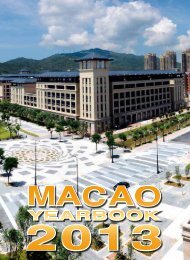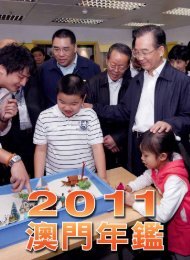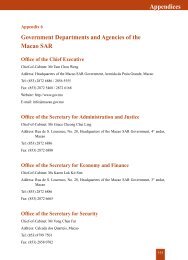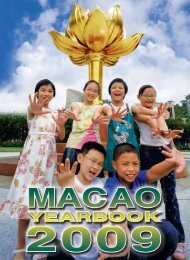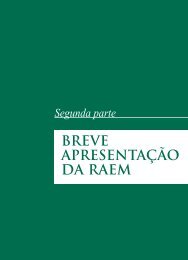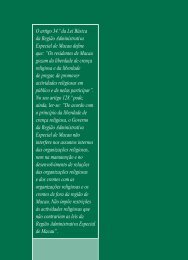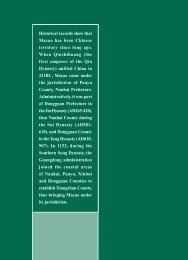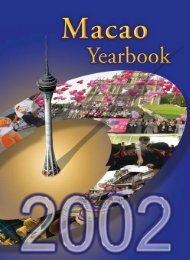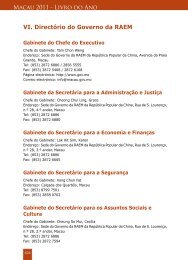Culture and Sport - Macao Yearbook
Culture and Sport - Macao Yearbook
Culture and Sport - Macao Yearbook
Create successful ePaper yourself
Turn your PDF publications into a flip-book with our unique Google optimized e-Paper software.
Communications Museum of <strong>Macao</strong><br />
<strong>Culture</strong> <strong>Culture</strong> <strong>and</strong> <strong>and</strong> <strong>Sport</strong> <strong>Sport</strong><br />
Inaugurated on 1 March 2006, the Communications Museum of <strong>Macao</strong> aims to promote stamp<br />
collecting <strong>and</strong> the stamps of <strong>Macao</strong> to citizens <strong>and</strong> tourists. In 2011, it received a total of 30,804<br />
visits, 58.49 percent of which were made by local teachers <strong>and</strong> students.<br />
<strong>Macao</strong> Tea <strong>Culture</strong> House<br />
The <strong>Macao</strong> Tea <strong>Culture</strong> House, which is managed by the Civic <strong>and</strong> Municipal Affairs Bureau, is<br />
the first exhibition gallery in <strong>Macao</strong> devoted to displaying tea-related artefacts. It was opened to the<br />
public on 1 June 2005, with a total floor area of 1,076 square metres. Its huge collection includes<br />
19th-century tea paintings, Canton enamel export teapots, as well as items used in old tea houses<br />
<strong>and</strong> tea shops. Through short-term <strong>and</strong> long-term exhibitions of various formats, as well as various<br />
tea culture activities, it is dedicated to demonstrating <strong>Macao</strong>’s tea culture <strong>and</strong> everything about<br />
tea in China <strong>and</strong> the West. It also hopes to promote worldwide tea culture, knowledge <strong>and</strong> studies.<br />
During 2011, the Tea <strong>Culture</strong> House organised three exhibitions that attracted a total of 40,518<br />
visitors. It also provided 10 free guided tour services, which received 214 visitors.<br />
The House organised 22 Public Tea Tastings <strong>and</strong> Taste the Tasty <strong>Culture</strong> - Tea <strong>Culture</strong> Promotion<br />
Programme events, in which 1,239 visitors participated.<br />
Museum of Taipa <strong>and</strong> Coloane History<br />
Opened on 7 May 2006, the Museum of Taipa <strong>and</strong> Coloane History consists of nine exhibition<br />
rooms <strong>and</strong> a souvenir shop. Built in 1920, the 638-square-metre, two-storey museum building was<br />
formerly the building of the former Isl<strong>and</strong> Municipal Council of Taipa.<br />
On the first floor are relics unearthed in Coloane, stone architectural remains of the basement,<br />
religious <strong>and</strong> cultural documents <strong>and</strong> relics from the transformations of the villages on the two<br />
isl<strong>and</strong>s. These items provide visitors with an overview of the early history <strong>and</strong> culture of Coloane<br />
<strong>and</strong> Taipa.<br />
The exhibition rooms on the second floor have different themes, including the history of the<br />
former Municipal Council of the Isl<strong>and</strong>s, a look back at agriculture <strong>and</strong> h<strong>and</strong>icrafts in the old days,<br />
the architectural features of buildings on Coloane <strong>and</strong> Taipa <strong>and</strong> the recent development of the<br />
two isl<strong>and</strong>s. It provides visitors with a better underst<strong>and</strong>ing of the modern political <strong>and</strong> economic<br />
development of Coloane <strong>and</strong> Taipa.<br />
The Museum of Taipa <strong>and</strong> Coloane History attracted a total of 47,006 visitors in 2011. It provided<br />
23 free guided tours, which received a total of 691 visitors. The Museum continued to showcase<br />
the Nighttime Drama Show – The Dramatic Dream of Taipa, with a new play, Back to the Future<br />
2101, which allowed audiences to learn the history of Taipa <strong>and</strong> Coloane in a relaxing way. There<br />
were 20 shows during the year, attracting 267 people.<br />
Iong Sam Tong Pavilion<br />
Iong Sam Tong Pavilion was built during the early 20th century as a part of Yu Yuen (the old name<br />
353



